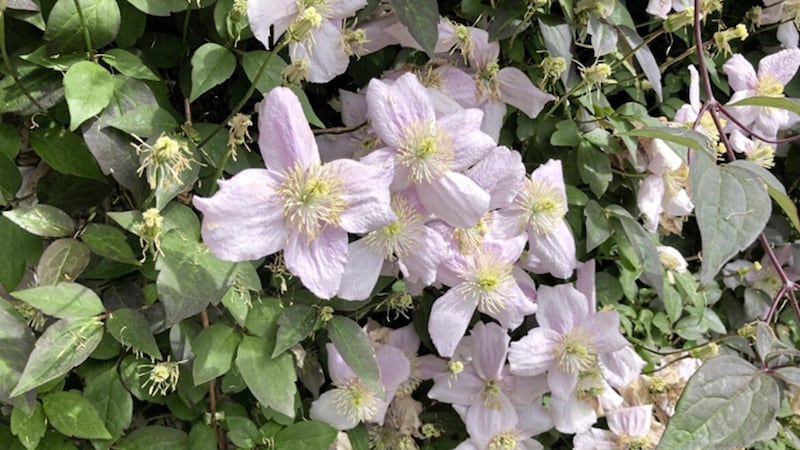Even when pushed I'm reluctant to call any plant my favourite. Tastes change over time and there are of course seasonal variations. Once, in my naive period, Crocosmia 'Lucifer' topped the list, its upright blade-like leaves and fiery red flowers mesmerised me. I still love it, but the behaviour of its invasive cousin Crocosmia x crocosmiiflora (AKA monbretia) has somewhat tempered my adoration. I'm also a big fan of snowdrops, the first flower of the year in my garden, a delightful, diminutive harbinger of spring that naturalises over the years first into clumps then into a beautiful white carpet. Other favourites coming into bloom soon include Allium 'Globemaster', Persicaria affinis 'Superba' and Geranium 'Rozanne'.
Yet standing head and shoulders above these great performing perennials in the coming weeks, both literally and figuratively, is Clematis viticella ‘Etoile Violette’, a tough plant that’ll survive under most conditions and can always be relied upon to deliver the money shot – which explains why it frequently tops surveys of the easiest varieties to grow. More disease resistant than most of its siblings, ‘Etoile Violette’ produces numerous scrambling stems of up to 4m on which loads of dark purple saucer-sized flowers appear in mid-to-high summer. It falls into the third of the three groups of clematis; those which produce flowers on the current season’s growth and should therefore be pruned in late winter/early spring, in my experience quite hard to around 15cm-30cm. It'll flower from late June onwards. Other varieties in Group 3 include Clematis viticella 'Kiev', Clematis x durandii and Clematis viticella 'Jorma'.
I have the ‘Etoile Violette’ planted to grow on a chicken wire support up the side of the house, alongside Clematis montana 'Fragrant Spring', an earlier-flowering and even more robust and vigorous variety. A wren has made its nest among the profusion of soft pink petals with a yellow centre. Washing the dishes, you can watch the mother flit from the nest, returning minutes later, her tiny beak brimming with worms. I'm assuming it's the mother, as I've learned wrens are "highly polygamous", and that males can have up to four partners at once within their territory, each with their own nest. It sounds fun at first but must be exhausting for the wee fella.
There'll be no pruning as long as the wren is nesting but ordinarily the C montana would be cut back judiciously after flowering in early June for several reasons – to keep it under control; to make more room for the ‘Etoile Violette’; and to give it time over the remainder of the growing season to replace the stems that'll next year bear the flowers. It shares these characteristics with all Group 1 clematis – a group of spring bloomers that includes C. alpina subsp. sibirica. 'White Moth', C. armandii, and C. marmoraria.
Group 2 clematis flower firstly in spring and early summer on shoots produced in the previous year, then in mid and late summer on new growth. Varieties are typically very showy and include 'Nelly Moser', ‘Doctor Ruppel’ and ‘Fireworks’. They'll benefit from a prune as long as the timing is right, otherwise you jeopardise flowering. To encourage branching and vigorous growth, all the stems should be pruned to around 30cm in late winter of the first year. In the subsequent years progressively move from pruning at around head height to merely tidying up by cutting back to buds and removing dead stems.






